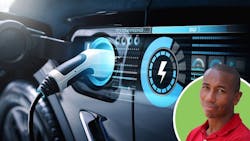If we’re to accept the future according to William Hanna and Joseph Barbera, then the world has 40 years exactly to go from internal combustion engines to flying cars. The Jetsons, which took place in 2062 featured vehicles that not only flew but also collapsed into a briefcase (how’s that for nifty?).
And while you and I both know we won’t be arriving at VISION 2062 in a Tesla Skyster, the chances may be greater than we get there in 2042 by EV.
In this month’s issue, we take a look at how shops need to prepare for electric vehicles. With the federal government aggressively pushing states to embrace electric vehicles, the time to prepare is now. We spoke with Craig Van Batenburg, Carolyn Coquillette, and Joe Pegararo to get their take on how shops need to ease into this brave new auto care world with respect to EV training, hybrid intake, ADAS work, and the need for shop owners to think about how these technologies will change the everyday workings of their shops.
And while shop owners need to stay up on trends, columnist Aaron Stokes advises shop owners to not be too hasty at the same time. Following the information matters, but don’t be the early adopter who invests hard-earned money without first seeing a clear pattern and a forward path emerge.
Perhaps something to file under things not considered, EV weight is causing quite the stir on U.S. highways. Sarah Amico, an executive chairperson with Jack Cooper, a North American car haul company that has delivered finished vehicles for many auto manufacturers talks about the challenge of transporting EVs. According to a CNet report, “an F-150 Lightning's battery alone weighs around 1,800 pounds, leading to a truck that weighs about 1,000 pounds more than the gas-engine gas-engine version, even without an engine or transmission.” This means a higher expense to ship EVs and longer for customers and dealerships to receive them.
There’s still much to learn about EVs, as we learned from Floridians during Ian, and I think that’s exciting. Much the same as a software beta test or a clinical trial, we have to see the successes and failures in real time. The latter doesn't mean the product is faulty, flawed, or will never catch on. It just means a better way has to emerge for the benefit of consumers and that means understanding how to repair it for their sake as well.
As we close out an exciting 2022, I invite you to visit our sister publication, ADAPT Automotive (adaptautomotive.com), to stay up-to-date with the latest news, trends, training, and influencers who are on the cutting edge of new technology and electrification. And with its timeless names, we'll not only be the first to make sure you get the scoop on EVs and ADAS, but we'll be the first to let you know when the next Ford Anglia takes flight.
About the Author
Chris Jones
Group Editorial Director
Chris Jones is group editorial director for the Vehicle Service & Repair Group at EndeavorB2B.
A multiple-award-winning editor and journalist, and a certified project manager, he provides editorial leadership for the auto care industry's most trusted automotive repair publications—Ratchet+Wrench, Modern Tire Dealer, National Oil & Lube News, FenderBender, ABRN, Professional Distributor, PTEN, Motor Age, and Aftermarket Business World.
Subscribe to receive news and updates from any of these industry-leading brands.

